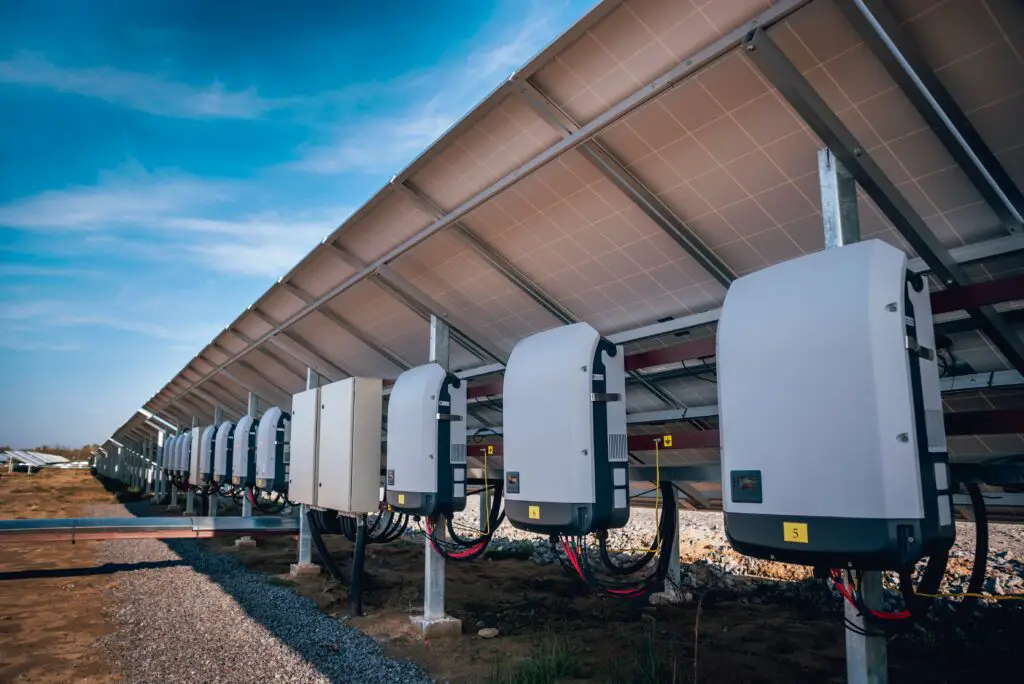According to Pennsylvania State University, high-quality sine wave inverters, which produce a smooth, consistent wave of AC power that closely mimics the power supplied by the grid, typically have an efficiency between 90% and 95%.
Modified sine wave inverters, which are generally lower in quality and produce a more stepped or blocky wave, have lower efficiencies, typically 75% to 85%. These inverters are less suitable for sensitive electronic equipment.
The efficiency of a solar inverter is critical, as it determines how effectively the inverter converts DC (Direct Current) power from the solar panels into AC (Alternating Current) power for use in homes or businesses.
Peak Efficiency
The peak efficiency of an inverter tells you how good it is at turning the DC energy from your solar panels into AC energy for your house when it’s working at its best.
Simply put, it measures the inverter’s top performance level.
CEC Efficiency
This stands for the efficiency rating set by the California Energy Commission.
It’s a more realistic efficiency measure because it considers how the inverter performs under different conditions, not just the best ones.
Since solar energy input varies during the day (like when there’s indirect sunlight), the CEC efficiency accounts for how the inverter handles different power levels and voltages.
This gives you a better idea of the inverter’s actual efficiency on an average sunny day, instead of just its ideal performance.
What Affects Solar Inverter Efficiency?
Here’s a deeper look into the factors affecting inverter efficiency:
Conversion Losses
Some power is inevitably lost during the conversion process, often in the form of heat.
This loss is a key factor in determining the efficiency of an inverter.
Load Dependence
The efficiency of an inverter is not constant and varies depending on the load it is handling.
Inverters operate with different efficiency levels at different percentages of their rated capacity.
Many inverters reach their peak efficiency at a specific load level, which is usually around 20% to 30% of their maximum capacity.
Efficiency can decrease when the load is too low or too high.
Thus it’s important to choose an inverter that matches your typical power usage to ensure that you are operating near this optimal efficiency level as much as possible.
Stand-by Power Consumption
Inverters consume some power to stay in ‘powered’ or ready mode.
While this consumption is generally small, it can impact the overall efficiency, especially in systems where the inverter is on standby for long periods.
Why Is Solar Inverter Efficiency Important?
The efficiency of a solar inverter significantly impacts the total energy produced by a solar installation.
Since all the electricity generated by the installation passes through the inverter, its efficiency is crucial.
For instance, with an 80% efficient inverter, 20% of the electricity is lost, while a 98% efficient inverter only loses 2%.
Consider a solar installation producing 7,000 kilowatt-hours (kWh) annually.
Over 25 years, this amounts to 175,000 kWh. Assuming each kWh is valued at $0.13 , increasing annually by 2.6%, here’s how inverter efficiency affects the total value:
- A hypothetical 100% efficient inverter would yield 175,000 kWh, totaling $31,489.
- A 98% efficient inverter results in 171,500 kWh and $30,859, losing $630 compared to the 100% efficient scenario.
- A 96% efficient inverter generates 168,000 kWh, valued at $30,229, losing $1,260.
- An 80% efficient inverter produces 140,000 kWh, with a value of $25,191, losing $6,298.
While a 100% efficient inverter is unrealistic and 80% is unacceptably low, this context helps to understand the efficiency impact.
The difference between 98% and 96% efficiency equates to approximately $600 over 25 years, or about $24 annually.
When selecting an inverter, the aim is to maximize financial savings without overspending.
For example, an inverter that’s 2% more efficient might generate an extra $600 in electricity over 25 years, but if it costs $1,000 more, the investment might not be justified.
Choosing the right inverter involves weighing its efficiency against the cost.
If a premium inverter costs $2,000 more for just a 2% efficiency gain, it may not be worthwhile.
To make an informed decision, compare the potential electricity production in kilowatt-hours of different inverters and convert that into monetary terms, considering your specific electricity costs.
It’s also beneficial to consult with your installer for tailored advice.








